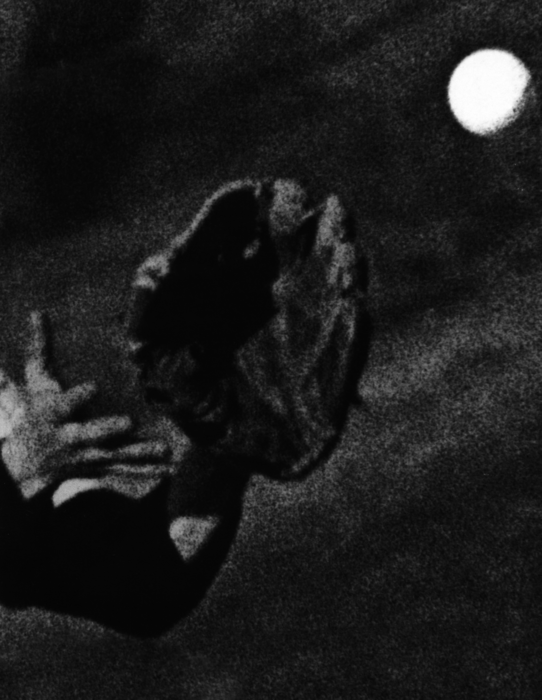The intellectual jokester, professorial leading light and California conceptualist has a running penchant for deadpan games, how-to fuck-ups and stock photography. In one deep and ongoing series of paintings drawn from production stills and newspaper leavings, games of power get handily played out, whether by smug developers standing around their newest tower or one desperado outgunning another. But the artist still has the last laugh. Baldessari once told me that in the case of those developers, he disliked their self-satisfied smirks so much that it inspired him to cover their faces with coloured dots, and one of the great artist’s stylistic signatures was born. Though Warhol’s celebrities might be better remembered in a century’s time for the artist’s portraits than their own stardom, Baldessari’s various leading men and starlets will be nary remembered except as floating coloured spots.
This month ArtReview did not ask the august artist about his own work specifically (however we poke at power or impress others with our own) but about the relationship he and all of us have to power. The word makes me as uncomfortable as Baldessari when I lob it at him in the first question of our conversation. He makes no special claims to knowledge, but assures me he’ll do his best. Once uttered, though, what power constitutes seems altogether fluid.
Such questions of course are not often asked of artists, but there’s no denying that, in one form or another, Baldessari has power. His umpteenth retrospective, Pure Beauty, just danced its way across Europe and North America with stops at Tate Modern in London and the Metropolitan in New York, his international reputation is at the pinnacle of global art (with prices to match). How powerful is John Baldessari? Well, that’s a tough metric. Did it take dozens of emails, and then, even once a time had been appointed, conversations with three different assistants to speak with him? Yes, it did. The moment I get to the man himself, however, all the layers of silliness seem silly, and he is wholly human, friendly and kind, unpretentious in that way we hope heroes are and which they often aren’t. He takes a break from his work – at eighty-one, the artist is still in full production – to talk. Throughout our conversation, Baldessari is reluctant to weigh in specifically about power (artists rightly prefer to talk about art), but we weave through a gaggle of symbolic stand-ins, starting, of course, with money. “When I started nobody expected to sell anything. It was a running joke that if you sold something you were doing something wrong.” Having taught at art colleges since 1970, first at CalArts, before moving to UCLA in 1986 for 22 years, Baldessari is placed to see a change in attitude. “In the mid-80s or so, students started asking me seriously about galleries, sales and the like, and it hasn’t stopped since.”
“I’m not against money per se, we need it to make the artworld work,” he continues. “But often it appears that too many people equate a higher price with higher aesthetic value.” As he speaks, I am reminded of a famous bit of self-serving drivel from Sotheby’s worldwide head of contemporary art, Tobias Meyer: ‘The best art is the most expensive because the market is so smart.’ Some might argue that Baldessari’s attitude is an avant-garde holdover, Warholian justifications and an auctioneer’s bon mots sadly ruling the marketplace.
Albeit undeniable in its power, money is only one boogeyman for power, which the list can attest to, for power is diffuse in its forms. Baldessari baulks at curators replacing artists, but grows pensive when faced with the question about his own power. “I guess if I have any power, I try to wield it benignly. If a curator asks me about what things I’ve seen and if they’re any good, I tell them about artists I believe in. But sometimes there are effects one couldn’t expect.”
He then tells me about his recent cycle through the papers for things other than artwork: his resignation from the board at the Museum of Contemporary Art in our hometown of Los Angeles, an act that caused all the artist trustees at the museum (Barbara Kruger, Catherine Opie and Ed Ruscha) to resign, galvanising sharp criticism of the director, former art dealer and perennial impresario Jeffrey Deitch, and his programming. “I just thought I’d been doing it for a long time and I wasn’t happy with the direction of the museum, so I told them I was stepping down. I didn’t really expect all to happen that did.”
Though we are assigned to talk about power, our conversation drifts into art. “I remember seeing Mondrian’s Broadway Boogie Woogie for the first time,” Baldessari recalls. “It brought tears to my eyes. I couldn’t explain why exactly, but I suppose that’s a different kind of power.”
This article originally appeared in the November 2012 issue alongside the Power 100 list
